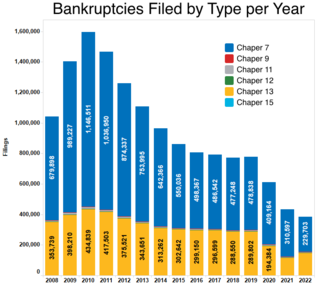Related Research Articles
Bankruptcy is a legal process through which people or other entities who cannot repay debts to creditors may seek relief from some or all of their debts. In most jurisdictions, bankruptcy is imposed by a court order, often initiated by the debtor.
Chapter 11 of the United States Bankruptcy Code permits reorganization under the bankruptcy laws of the United States. Such reorganization, known as Chapter 11 bankruptcy, is available to every business, whether organized as a corporation, partnership or sole proprietorship, and to individuals, although it is most prominently used by corporate entities. In contrast, Chapter 7 governs the process of a liquidation bankruptcy, though liquidation may also occur under Chapter 11; while Chapter 13 provides a reorganization process for the majority of private individuals.
Personal bankruptcy law allows, in certain jurisdictions, an individual to be declared bankrupt. Virtually every country with a modern legal system features some form of debt relief for individuals. Personal bankruptcy is distinguished from corporate bankruptcy.
Debt restructuring is a process that allows a private or public company or a sovereign entity facing cash flow problems and financial distress to reduce and renegotiate its delinquent debts to improve or restore liquidity so that it can continue its operations.

In the United States, bankruptcy is largely governed by federal law, commonly referred to as the "Bankruptcy Code" ("Code"). The United States Constitution authorizes Congress to enact "uniform Laws on the subject of Bankruptcies throughout the United States". Congress has exercised this authority several times since 1801, including through adoption of the Bankruptcy Reform Act of 1978, as amended, codified in Title 11 of the United States Code and the Bankruptcy Abuse Prevention and Consumer Protection Act of 2005 (BAPCPA).
In accounting, insolvency is the state of being unable to pay the debts, by a person or company (debtor), at maturity; those in a state of insolvency are said to be insolvent. There are two forms: cash-flow insolvency and balance-sheet insolvency.
A fraudulent conveyance or fraudulent transfer is the transfer of property to another party to prevent, hinder, or delay the collection of a debt owed by or incumbent on the party making the transfer, sometimes by rendering the transferring party insolvent. It is generally treated as a civil cause of action that arises in debtor/creditor relations, typically brought by creditors or by bankruptcy trustees against insolvent debtors, but in some jurisdictions there is potential for criminal prosecution.
Restructuring or Reframing is the corporate management term for the act of reorganizing the legal, ownership, operational, or other structures of a company for the purpose of making it more profitable, or better organized for its present needs. Other reasons for restructuring include a change of ownership or ownership structure, demerger, or a response to a crisis or major change in the business such as bankruptcy, repositioning, or buyout. Restructuring may also be described as corporate restructuring, debt restructuring and financial restructuring.
A debtor in possession or DIP in United States bankruptcy law is a person or corporation who has filed a bankruptcy petition, but remains in possession of property upon which a creditor has a lien or similar security interest. A debtor becomes the debtor in possession after filing the bankruptcy petition. A corporation which continues to operate its business under Chapter 11 bankruptcy proceedings is a debtor in possession.
As a legal concept, administration is a procedure under the insolvency laws of a number of common law jurisdictions, similar to bankruptcy in the United States. It functions as a rescue mechanism for insolvent entities and allows them to carry on running their business. The process – in the United Kingdom colloquially called being "under administration" – is an alternative to liquidation or may be a precursor to it. Administration is commenced by an administration order.
The insolvency law of Switzerland is the law governing insolvency, foreclosure, bankruptcy and debt restructuring proceedings in Switzerland. It is principally codified in the Federal Statute on Debt Enforcement and Bankruptcy of 11 April 1889 as well as in ancillary federal and cantonal laws.

Peter S. Kaufman is an American investment banker and private equity investor. He is the President and Head of Restructuring and Distressed M&A at Gordian Group LLC, an investment banking firm. He is also a Managing Partner of Bacchus Capital Management, a winery investment concern.
The Companies' Creditors Arrangement Act is a statute of the Parliament of Canada that allows insolvent corporations owing their creditors in excess of $5 million to restructure their businesses and financial affairs.
The Winding-up and Restructuring Act is a statute of the Parliament of Canada that provides for the winding up of certain corporations and the restructuring of financial institutions. It was passed in 1985, and has been amended since. Predecessors of the act date back to 1882.

British Virgin Islands bankruptcy law is principally codified in the Insolvency Act, 2003, and to a lesser degree in the Insolvency Rules, 2005. Most of the emphasis of bankruptcy law in the British Virgin Islands relates to corporate insolvency rather than personal bankruptcy. As an offshore financial centre, the British Virgin Islands has many times more resident companies than citizens, and accordingly the courts spend more time dealing with corporate insolvency and reorganisation.

Cayman Islands bankruptcy law is principally codified in five statutes and statutory instruments:
The UNCITRAL Model Law on Cross-Border Insolvency was a model law issued by the secretariat of UNCITRAL on 30 May 1997 to assist states in relation to the regulation of corporate insolvency and financial distress involving companies which have assets or creditors in more than one state.
Australian insolvency law regulates the position of companies which are in financial distress and are unable to pay or provide for all of their debts or other obligations, and matters ancillary to and arising from financial distress. The law in this area is principally governed by the Corporations Act 2001. Under Australian law, the term insolvency is usually used with reference to companies, and bankruptcy is used in relation to individuals. Insolvency law in Australia tries to seek an equitable balance between the competing interests of debtors, creditors and the wider community when debtors are unable to meet their financial obligations. The aim of the legislative provisions is to provide:

Hong Kong insolvency law regulates the position of companies which are in financial distress and are unable to pay or provide for all of their debts or other obligations, and matters ancillary to and arising from financial distress. The law in this area is now primarily governed by the Companies Ordinance and the Companies Rules. Prior to 2012 Cap 32 was called the Companies Ordinance, but when the Companies Ordinance came into force in 2014, most of the provisions of Cap 32 were repealed except for the provisions relating to insolvency, which were retained and the statute was renamed to reflect its new principal focus.
The Insolvency and Bankruptcy Code, 2016 (IBC) is an Indian law which creates a consolidated framework that governs insolvency and bankruptcy proceedings for companies, partnership firms, and individuals.
References
- ↑ Lyndon Maither, B.C. (2013). The Canada Income Tax Act: Enforcement, Collection, Prosecution, 4th Ed. Lyndon Maither. p. 319. ISBN 9781300772286.
- ↑ Stuhl, S.A.; Vault (Firm) (2003). Vault Guide to Bankruptcy Law Careers. Vault Incorporated. p. 147. ISBN 9781581312577.
- ↑ Liu, L. (2008). Subnational Insolvency: Cross-Country Experiences and Lessons. World Bank. p. 20.
- ↑ Lyndon Maither, B.C. The Canada Income Tax Act: Enforcement, Collection, Prosecution, 6th Edition.
- ↑ Hecker, J.E.Z. (2006). Commercial Aviation: Bankruptcy and Pension Problems Are Symptoms of Underlying Structural Issues. DIANE Publishing Company. p. 10. ISBN 9781422304327.
- ↑ Engel, G.T. (2010). Financial Audit: Office of Financial Stability (Troubled Asset Relief Program) Fiscal Year 2009 Financial Statements. DIANE Publishing Company. p. 61. ISBN 9781437926811.
- ↑ Barofsky, N. (2011). Troubled Asset Relief Program (SIGTARP): Quarterly Report to Congress by the Office of the Special Inspector General (SIGTARP)(October 26, 2010). DIANE Publishing Company. p. 145. ISBN 9781437942019.
- ↑ Warren, E. (2010). Use of TARP Funds in the Support and Reorganization of the Domestic Automotive Industry. DIANE Publishing Company. p. 44. ISBN 9781437923698.
- ↑ Pomerleano, M.; Shaw, W.; Bank, W. (2005). Corporate Restructuring: Lessons from Experience. World Bank. p. 130. ISBN 9780821359280.